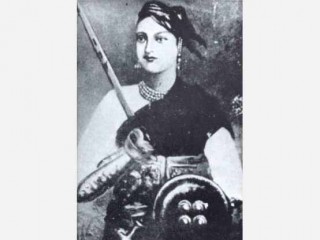
Lakshmi Bai biography
Date of birth : 1835-11-19
Date of death : 1858-06-17
Birthplace : Kashi(Varanasi), India
Nationality : Hindi
Category : Historian personalities
Last modified : 2010-06-21
Credited as : Queen of Jhansi, Rani of Jhansi,
3 votes so far
Lakshmi bai was born around 1830 into a wealthy, high-caste family. She was named Manukarnika, which is one of the names of the holy river Ganges. As a young woman, she learned to read, write and debate. She also learned to ride horses and use weapons while playing with her adopted brothers. She accepted the name Lakshmi Bai when she married Gangadhar Rao, the maharajah of Jhansi and became the Rani (short for maharani, the wife of maharajah) of Jhansi.
Gangadhar Rao was between forty and fifty years of age at the time of their wedding. This was his second marriage. His first wife died without producing an heir. The new Rani of Jhansi gave birth to a son, but he died when he was three months old. Subsequently, Damodar Rao, Gangadhar’s relative, became their adopted son. In 1853, Gangadhar Rao died.
The Governor-General of India, the Marquess of Dalhousie, announced that since Gangadhar Rao left no heir, the state of Jhansi would be annexed by the British Government. The British rejected the claim that Damodar Rao was the legal heir. According to Hindu law, little Damodar Rao was Gangadhar’s heir and successor. In the Hindu religion, a surviving son, either biological or adopted, had an obligation to perform certain sacrifices after his father’s death to prevent his father from being condemned to punishment or hell. The refusal of the British to acknowledge the legitimacy of Rajah’s adopted son caused a serious consternation in the local population. Rani appealed her case to London, but that appeal was turned down.
Not wishing to give up her kingdom, Lakshmi Bai assembled a volunteer army of 14,000 rebels and ordered that defenses of the city itself be strengthened. Jhansi was attacked by the British in March 1858. Shelling of Jhansi was fierce and the British were determined not to allow any rebels to escape while Rani was determined not to surrender. The British noted that the Indian soldiers fighting them showed more vigor than they ever had while following British orders. Women were also seen working the batteries and carrying ammunition, food and water to the soldiers. Rani, herself, was seen constantly active in the defense of the city. Jhansi, however, fell to the British forces after a two week siege. A priest from Bombay who witnessed the British victory, said that what followed were four days of fire, pillage, murder and looting without distinction. He said it was difficult to breathe due to strong smell of burning flesh. British historians, on the other hand, suggested that while four to five thousand people died in battle, the civilians were spared.
The Rani managed to escape on horseback under the cover of darkness and within twenty-four hours rode over one hundred miles to the fortress of Kalpi. Several other Indian rulers joined the rebel forces there. It is believed that the Rani was influential in convincing the others to go on the offensive and seize the fortress of Gwalior. This maneuver was successful and helped rally the rebel forces together.
















